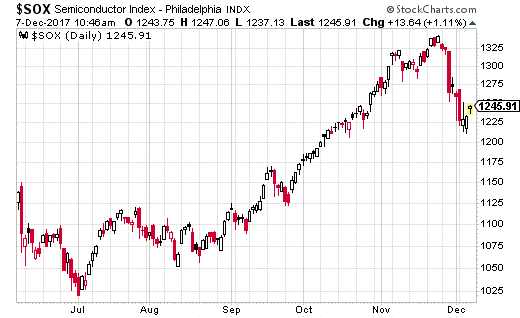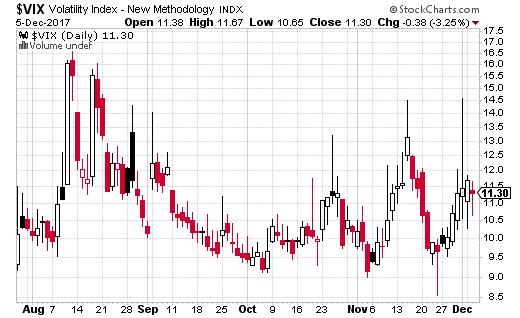2017 isn’t exactly going out with a bang – but it’s also not ending with a whimper either. We’re actually seeing higher levels of volatility than what we’ve experienced most of the year. Granted, volatility (as measured by the VIX) has been historically low in recent months. However, the end of the year so far is proving to be a bit more interesting.
First off, we’re seeing a fairly substantial rotation out of tech stocks and into financials and other sectors. Tech stocks have been driving the market this year and valuations have definitely gotten a bit frothy. Moreover, financials should see benefits from higher interest rates coming in 2018 and beyond.
Tech has been hit pretty hard – especially the chip stocks – and this may have caught some investors off guard. Surprising investors is certainly one way to get volatility to go higher. The Semiconductor Index chart below makes this pretty clear.

Of course, there are several other factors contributing to relatively higher VIX levels, most of them political in nature. The tax reform bill has been front and center in terms of financial news. Who knows what the final version of the bill will end up looking like, but it seems pretty certain it will be a boon for corporations. Any serious issues with the bill (eventually) passing could certainly add to market volatility.
There’s also the threat of government shutdown, although by the time you read this, I predict a short-term deal will already be in place.
Finally, there’s the Mueller investigation regarding the current administration and Russian interference with the election. This case seems to have some legs to it, although the impact on the stock market remains nebulous at best. Even if high ranking members of the administration are forced to resign, it really shouldn’t change much in terms of economics. Once again, I expect a business-favorable tax plan to pass regardless.
SEE ALSO: This “21st Century Pension Plan” Pays You Income for LIFE
Keep in mind, political news tends to create short-term volatility. Long-term changes in volatility are mostly the result of economics. A political scandal is generally a short-term situation. A tax bill is long-term.
That being said, plenty of big VIX trades are hitting the wire – and the majority of them are focused on the VIX moving higher. Of course the VIX is the main instrument used for hedging, so it stands to reason that most big trades in VIX options would be on the long side. Nevertheless, you can tell a lot of what hedgers are thinking about risk levels by what strikes they use.
For instance, a sizeable trader recently purchased 50,000 January VIX 20 calls for $0.50. That’s a $2.5 million bet that the VIX breaks above $20.50 by mid-January. Of course for that kind of money, this is clearly a hedge. The VIX hasn’t been above 20 in over a year – and hasn’t even been particularly close this year.

As someone who is generally a seller of volatility, I don’t like spending a lot of money going long VIX whether it’s a hedge or a speculative bet. As such, I’d prefer to do a long call spread rather than buying calls straight up. As an example, if you think the VIX is going to move higher or want to hedge, you could buy the January 13-18 call spread (buying the 13, selling the 18) for about $0.80.
It’s a good way to keep your costs low while also providing decent upside potential. A max loss of $0.80 with a max gain of $4.20 (if VIX is at $18 or above by January expiration) is certainly a good ratio to have on a call spread.
[FREE REPORT] Options Income Blueprint: 3 Proven Strategies to Earn More Cash Today Discover how to grab $577 to $2,175 every 7 days even if you have a small brokerage account or little experience... And it's as simple as using these 3 proven trading strategies for earning extra cash. They’re revealed in my new ebook, Options Income Blueprint: 3 Proven Strategies to Earn Extra Cash Today. You can get it right now absolutely FREE. Click here right now for your free copy and to start pulling in up to $2,175 in extra income every week.
Source: Investors Alley
